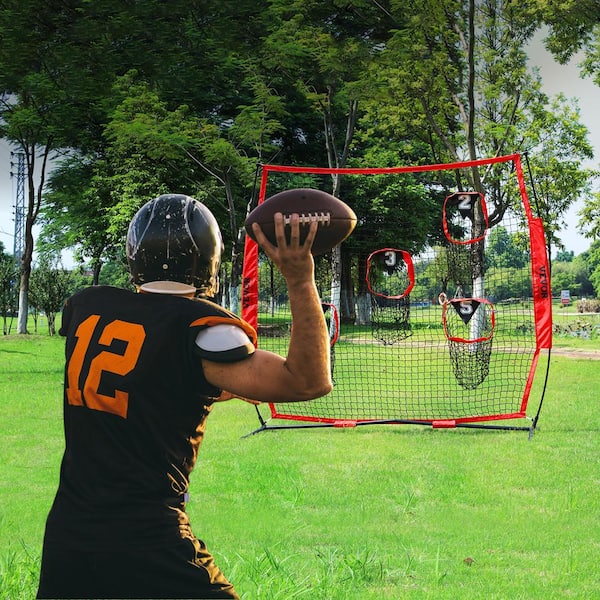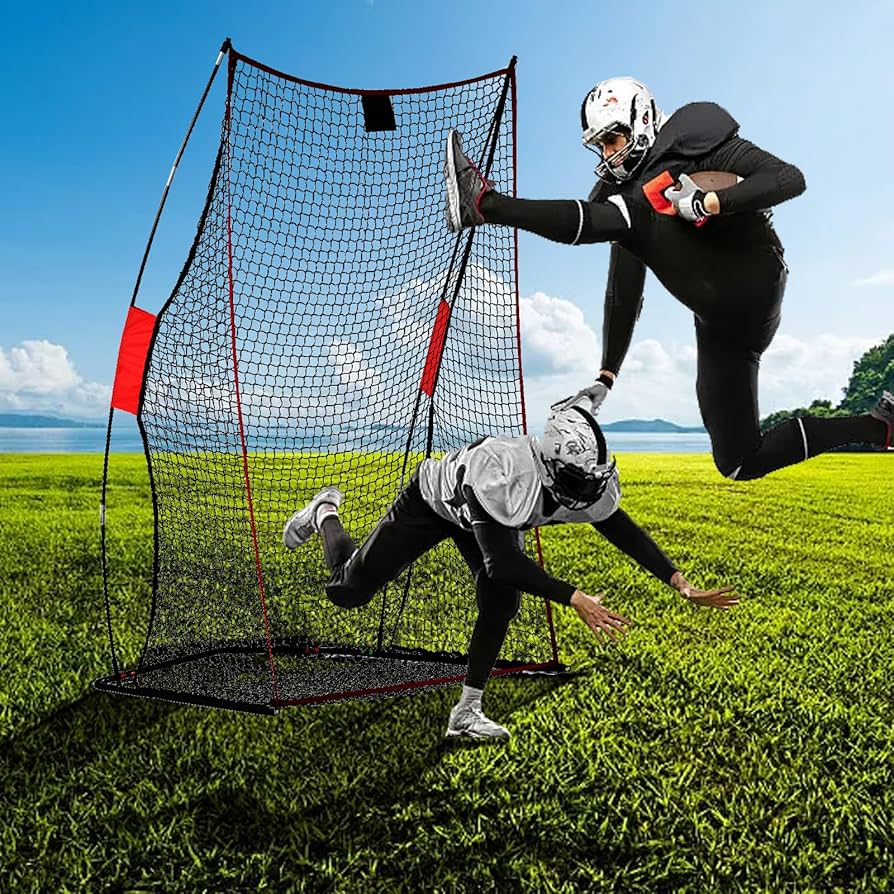What is a Football Pocket?
How big is the pocket in football? In football, the term ‘pocket’ describes a safe area created by offensive linemen. This protective space is where the quarterback stands to throw the ball. It’s a small zone, shaped like an arc. This arc curves around the quarterback. Imagine an invisible shield that keeps defensive players at bay. The pocket’s size is not fixed; it fluctuates with each play. It depends on the offensive line’s formation and the play called by the team. Offensive players work hard to keep the pocket intact. They block defenders who try to break through and disrupt the quarterback. A stable pocket gives the quarterback time to scan the field, make decisions, and pass the ball effectively. The quality of the pocket can be the difference between a successful play and a sack. So, understanding the pocket is crucial for anyone seeking insight into football strategies.

The Importance of Pocket Size in Football Strategy
The size of the pocket in football holds great strategic importance. It can directly influence the outcome of a play. A larger pocket provides the quarterback with more room to maneuver. It allows them space to avoid defenders and execute plays with greater vision. Thus, quarterbacks can make more accurate throws. However, creating a larger pocket often requires more resources. More offensive linemen may need to defend against aggressive defenders.
Conversely, a smaller pocket may limit the quarterback’s vision and mobility. It leaves them more vulnerable to sacks. The chances of making a successful pass decrease as space tightens. Nonetheless, a smaller pocket can be a strategic choice. It can lead to quicker plays when time is of the essence. Also, it may be part of a strategy to draw defenders in, creating opportunities for running or unexpected plays.
In essence, the pocket size shapes the quarterback’s capability to execute a play. Coaches and players must consider how big the pocket in football should be for each scenario. They factor in the team’s strengths, the opponent’s defense strategy, and the specific game situation. It’s a delicate balancing act. One that requires skill and precision to master. Pocket size is a crucial element that can dictate the pace and approach of the entire game.
Factors Influencing Football Pocket Size
Several factors determine how big the pocket in football can be during a game. Each factor interplays to shape this crucial zone for quarterbacks.
Offensive Linemen Tactics
The techniques and skills of offensive linemen are primary influencers. Good lineman coordination can expand the pocket effectively. Their ability to synchronize movements and block strategically is essential. Their strength and agility also play a role in maintaining the pocket size.
Defensive Strategies
Opposing defensive strategies also impact the pocket size. If the defense is aggressive with many players rushing, the pocket may shrink. Defensive tactics aiming to break through the offensive line force linemen to adjust, altering the pocket’s dimensions.
Play Type and Game Strategy
The type of play called impacts how big the pocket needs to be. Quick passes may require a smaller, tighter pocket. Plays intended for longer passes might need a larger pocket to give the quarterback more time and space. Game strategy also dictates pocket size, depending on how the team plans to navigate the opposing defense.
Quarterback’s Mobility and Style
A quarterback’s mobility can influence the planned size of the pocket. More mobile quarterbacks may perform better with a dynamic, shifting pocket. This style allows them to make movements and improvise as needed. Conversely, less mobile quarterbacks might rely more on a stable, larger pocket.
In summary, when evaluating how big the pocket in football should be, one must consider several tactical, physical, and strategic elements. These factors all contribute to the dynamic nature of the pocket in football plays.

Pocket Size Variations Among Different Football Leagues
Football leagues across the globe showcase distinct styles in pocket sizes. These variations might tie to league traditions or rules that shape the game. From the NFL to college football, and regional leagues, each exhibits its style.
In the NFL, the pocket tends to be larger. More space is standard for quarterbacks to maneuver and take longer passes. This reflects the league’s emphasis on complex offensive strategies. The larger pocket also correlates with the NFL’s focus on high-caliber passing games. Quarterbacks here often have strong arm capabilities and require that extra space.
Comparatively, college football might have tighter pocket sizes. The players are still developing skills. Game plans here bank on agility and the ability to execute quick plays. Different levels of player skill across teams can make larger pockets less feasible.
International and regional leagues introduce another layer of variation. Some may favor fast-paced games with smaller pocket sizes. They might focus on quick plays, rather than long passes. Their strategy might also depend on the mobility and style of the quarterbacks that dominate the league.
Rugby leagues, offering a different take on football, don’t have pockets as in American football. However, they rely on space around players, which serves a similar purpose for strategy.
In essence, how big the pocket in football is can swing widely from one league to another. This influences not just individual plays but the overall approach teams take towards offense and defense. As strategies differ across leagues, so does the dynamic of the pocket in football.
Measuring a Football Pocket: Techniques and Challenges
Measuring the pocket in football is not a straightforward task. Unlike many other aspects of the game, you cannot quantify the pocket’s size with a simple tape measure. The dynamic nature of the game and the constant movement of players mean that the pocket’s size is fluid and ever-changing. However, several methods can help us understand and evaluate the dimensions of this crucial space.
Technique: Observational Analysis
One common method is observational analysis. Coaches and analysts watch game footage to gauge pocket size. They look for the space the offensive line creates and how long it lasts. Observational analysis often involves recording and replaying plays. Analysts measure the pocket size at key points during a play.
Technique: Player Positioning Data
Another technique involves using player positioning data. New technology allows us to track where players are on the field. This data can give insights into just how big the pocket is at any given moment.
Challenges in Measurement
But these techniques come with challenges. For one, measuring in real-time is incredibly difficult. The fast-paced nature of the game means the pocket is constantly in flux. Additionally, subjectivity can taint observational analysis. Different viewers may perceive the size of the pocket differently. Recording and technology methods can be costly and are not always readily available, especially for lower-level leagues or teams with less funding.
In conclusion, while we can attempt to measure the pocket in football, it requires nuanced, often subjective, and technologically aided methods. These carry inherent challenges due to the game’s speed and complexity. Yet, despite these obstacles, understanding pocket size remains a critical component of football strategy analysis.
The Role of Offensive Linemen in Determining Pocket Size
Offensive linemen play a pivotal role in determining the size of the football pocket. Their primary job is to create and maintain a safe zone for the quarterback to operate within. The size of the pocket is largely in their hands. Here’s how they make an impact:
- Coordination and Strength: Linemen must work together to form a protective barrier. Strength is vital to withstand the push from defensive players.
- Blocking Schemes: The offensive line uses specific blocking schemes to either widen or compact the pocket depending on the play’s needs.
- Tactical Adjustments: Linemen must be quick to adjust their tactics. They react to defensive strategies and ensure the quarterback has space.
- Physical Attributes: The size and agility of each lineman contribute to how effectively they can expand or shrink the pocket.
Overall, the offensive linemen are the architects of the pocket. Their effectiveness directly influences the quarterback’s ability to execute plays. A capable line can mean the difference between a completed pass and a sack. When evaluating the pocket size, one must appreciate the critical role played by these unsung heroes on the field.
How Quarterbacks Utilize Various Pocket Sizes
Quarterbacks manipulate pocket sizes to enhance play execution. Here’s how they tailor their tactics:
- Quick Decisions in Tight Spaces: In smaller pockets, quarterbacks must make snap decisions. Fast releases and short passes are common. They need swift feet and a quick mind.
- Leveraging Larger Pockets: When the pocket is big, quarterbacks have more time. They can evaluate the field better. This space allows for deeper throws and complex plays.
- Adjusting to Mid-Play Changes: Sometimes, the pocket size changes during a play. Skilled quarterbacks can adapt their strategy on the fly. They use shifts in pocket size to their advantage, making strategic moves.
- Utilizing Pocket Movement: Mobile quarterbacks often benefit from shifting pockets. They roll out to extend plays and avoid defenders, using the pocket’s dynamics.
Understanding and utilizing these variations in pocket size is key for quarterbacks. They must continually assess the pocket and adapt their approach accordingly. This adaptive skill is crucial for optimizing passing game strategies.
Impact of Pocket Size on Passing Game Efficiency
The size of the football pocket significantly affects passing game efficiency. Here’s how:
- Time for Decision Making: A bigger pocket means more time for the quarterback. This extra time lets them assess the defense, improving pass accuracy.
- Room for Maneuvering: Ample space in a larger pocket allows quarterbacks to step up or move sideways. Such movement helps in avoiding sacks and finding better passing lanes.
- Pressure Handling: In smaller pockets, quarterbacks face more immediate pressure. They must release the ball quickly, which can lead to rushed decisions and possible interceptions.
- Impact on Play Varieties: The pocket size impacts what types of plays are called. Larger pockets allow for more complex, longer-developing plays, expanding the offensive playbook.
- Effect on Receiver Routes: Receivers rely on timing as much as quarterbacks. A stable pocket gives them the chance to complete their routes, maximizing the likelihood of a successful pass.
In conclusion, pocket size is a key component that influences the passing game’s success. Coaches must craft strategies that optimize pocket dimensions, harmonizing the quarterback’s skills with the offensive line’s capabilities. Effective use of the pocket can lead to higher pass completion rates and overall offensive efficiency.

